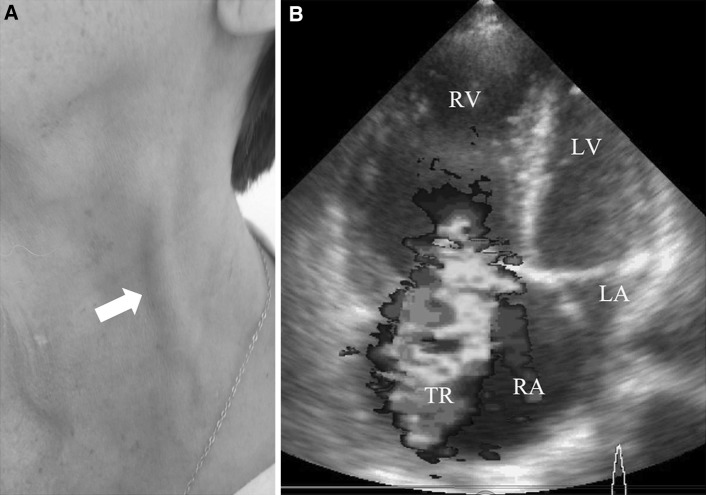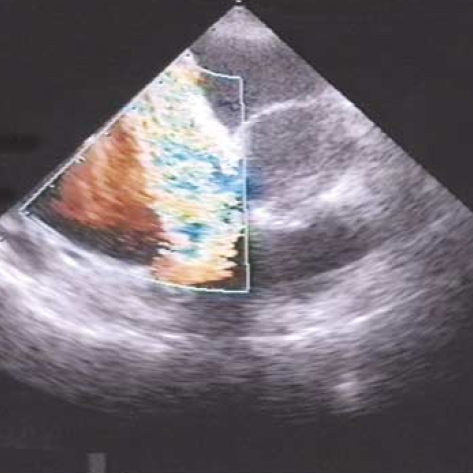Tricuspid regurgitation diagnostic study of choice: Difference between revisions
| Line 32: | Line 32: | ||
[[File:Severe tricuspid regurgitation.jpg|alt=Color-flow Doppler showing severe tricuspid regurgitation.|center|thumb|473x473px|Color-flow Doppler showing severe tricuspid regurgitation. Case courtesy by Sungwon Na et al<ref>{{Cite web|url=https://www.ncbi.nlm.nih.gov/pmc/articles/PMC2693829/|title=Traumatic Tricuspid Regurgitation Following Cardiac Massage|last=|first=|date=|website=|archive-url=|archive-date=|dead-url=|access-date=}}</ref>]] | [[File:Severe tricuspid regurgitation.jpg|alt=Color-flow Doppler showing severe tricuspid regurgitation.|center|thumb|473x473px|Color-flow Doppler showing severe tricuspid regurgitation. Case courtesy by Sungwon Na et al<ref>{{Cite web|url=https://www.ncbi.nlm.nih.gov/pmc/articles/PMC2693829/|title=Traumatic Tricuspid Regurgitation Following Cardiac Massage|last=|first=|date=|website=|archive-url=|archive-date=|dead-url=|access-date=}}</ref>]] | ||
<br /> | <br /> | ||
==References== | ==References== | ||
Revision as of 20:53, 18 April 2020
|
Tricuspid Regurgitation Microchapters |
|
Diagnosis |
|---|
|
Treatment |
|
Case Studies |
|
Tricuspid regurgitation diagnostic study of choice On the Web |
|
American Roentgen Ray Society Images of Tricuspid regurgitation diagnostic study of choice |
|
Tricuspid regurgitation diagnostic study of choice in the news |
|
Risk calculators and risk factors for Tricuspid regurgitation diagnostic study of choice |
Editor-In-Chief: C. Michael Gibson, M.S., M.D. [1]; Associate Editor(s)-in-Chief:
Overview
Tricuspid regurgitation is primarily diagnosed based on the findings in echocardiography. In tricuspid regurgitation patients echocardiography helps in evaluation of severity of the tricuspid regurgitation. Cardiovascular magnetic resonance (CMR) is helpful in estimation of right ventricular size and systolic function. Pulmonary artery hypertension can be evaluated by doing cardiac catheterization. ECG in the patients of TS helpful when the TR is severe.
Diagnostic Study of Choice
Study of choice
- The diagnostic study of choice for tricuspid regurgitation is echocardiography.
- Color flow doppler echocardiography is the best to evaluate tricuspid regurgitation.
- The following are findings in tricuspid regurgitation on echocardiography:[1][2][3][4][5][6]
- Tricuspid valve motion which may be normal to high based on the severity of the presentation.
- Characteristic primary valvular abnormalities can be detected by tricuspid valve motion which includes the conditions like:[7][8]
- Ebstein's anomaly
- Carcinoid heart disease
- Rheumatic valve disease
- Tricuspid valve prolapse
- Flail leaflet
- Endocarditis
- Right ventricle and right atrium dilation
- By using the vena contracta method with colour doppler we can estimate the severity of the tricuspid regurgitation and that includes:
- The vena contracta width has to be more than 0.7 cm along with systolic flow reversal in the hepatic veins
- In the presence of atrial fibrillation, systolic flow reversal in the hepatic veins cannot be accurate
- Dilation tricuspid annulus
- Paradoxical movement may noticed in interventricular septum
- Right ventricle function can be analysed
- By using the modified Bernoulli equation, we can estimate the pulmonary hypertension on echocardiography by measuring the right ventricle to right atrial systolic gradient from the velocity of the tricuspid regurgitation jet


References
- ↑ Chen TE, Kwon SH, Enriquez-Sarano M, Wong BF, Mankad SV (2013). "Three-dimensional color Doppler echocardiographic quantification of tricuspid regurgitation orifice area: comparison with conventional two-dimensional measures". J Am Soc Echocardiogr. 26 (10): 1143–1152. doi:10.1016/j.echo.2013.07.020. PMID 23993694.
- ↑ de Agustin JA, Viliani D, Vieira C, Islas F, Marcos-Alberca P, Gomez de Diego JJ; et al. (2013). "Proximal isovelocity surface area by single-beat three-dimensional color Doppler echocardiography applied for tricuspid regurgitation quantification". J Am Soc Echocardiogr. 26 (9): 1063–72. doi:10.1016/j.echo.2013.06.006. PMID 23860094.
- ↑ Zoghbi, William A.; Adams, David; Bonow, Robert O.; Enriquez-Sarano, Maurice; Foster, Elyse; Grayburn, Paul A.; Hahn, Rebecca T.; Han, Yuchi; Hung, Judy; Lang, Roberto M.; Little, Stephen H.; Shah, Dipan J.; Shernan, Stanton; Thavendiranathan, Paaladinesh; Thomas, James D.; Weissman, Neil J. (2017). "Recommendations for Noninvasive Evaluation of Native Valvular Regurgitation". Journal of the American Society of Echocardiography. 30 (4): 303–371. doi:10.1016/j.echo.2017.01.007. ISSN 0894-7317.
- ↑ Iurovskaia VP (1970). "[Polycystic ovaries]". Akush Ginekol (Mosk). 46 (8): 63–6. PMID 5494426.
- ↑ Hahn, Rebecca T.; Thomas, James D.; Khalique, Omar K.; Cavalcante, João L.; Praz, Fabien; Zoghbi, William A. (2019). "Imaging Assessment of Tricuspid Regurgitation Severity". JACC: Cardiovascular Imaging. 12 (3): 469–490. doi:10.1016/j.jcmg.2018.07.033. ISSN 1936-878X.
- ↑ Hudzik B, Poloński L, Gąsior M (2016). "Lancisi sign: giant C-V waves of tricuspid regurgitation". Intern Emerg Med. 11 (8): 1139–1140. doi:10.1007/s11739-015-1384-4. PMC 5114320. PMID 26758273.
- ↑ Adler, Dale S. (2017). "Non-functional tricuspid valve disease". Annals of Cardiothoracic Surgery. 6 (3): 204–213. doi:10.21037/acs.2017.04.04. ISSN 2225-319X.
- ↑ Paranon, S.; Acar, P. (2008). "Ebstein's anomaly of the tricuspid valve: from fetus to adult". Heart. 94 (2): 237–243. doi:10.1136/hrt.2006.105262. ISSN 1355-6037.
- ↑ "Lancisi sign: giant C-V waves of tricuspid regurgitation, transthoracic echocardiography 4-chamber view demonstrating a dilated right atrium and right ventricle and severe tricuspid regurgitation with a moderately reduced right ventricular function (RA right atrium, RV right ventricle, TR tricuspid regurgitation, LA felt atrium, LV left ventricle)".
- ↑ "Traumatic Tricuspid Regurgitation Following Cardiac Massage".